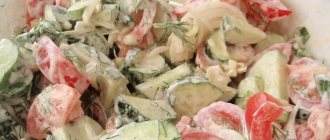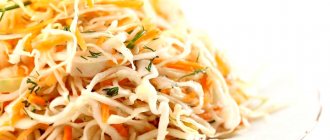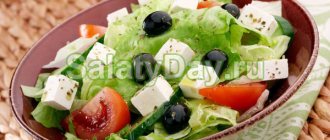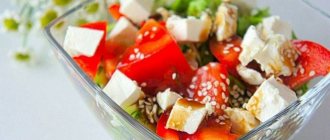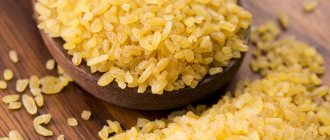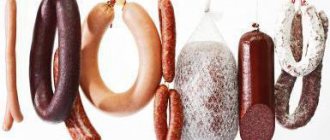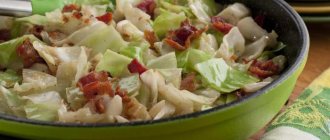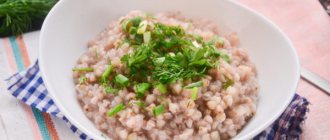Good day to you, my wonderful readers! How often do you eat the ultimate Greek salad? This is one of our family’s favorite dishes, and I can safely call it dietary, because I managed to “lighten” the recipe in terms of calories without changing its taste. How? You will learn more about this further.
The calorie content of the famous Greek salad in its classic version is about 140 calories per 100 grams of dish. On the one hand, this number of calories is already small. But who eats 100 grams of Greek salad? That's the same!
So it’s better to work with its calorie content, especially for those who want. What ways can you reduce calories without spoiling the taste of your favorite dish?
Classic Greek salad and its calorie content
So, what will we start from?
Of course, from the classic recipe:
- soft cheese (brynza, feta, in extreme cases - Adyghe) - 100 grams;
- 2-3 tomatoes – 150 grams;
- sweet pepper – 1-2 pieces – 150 grams;
- 1-2 cucumbers – 150 grams;
- greens - lettuce, parsley, basil;
- red onion – 1 piece – 70 grams;
- pitted olives – 100 grams;
- olive oil – 2-3 tablespoons;
- half a lemon;
- garlic, ground black pepper, salt.
Cut the onion into half rings, the rest of the vegetables and cheese into fairly large cubes. Add chopped herbs, olives, chopped garlic, salt and black pepper. Season the salad with oil and lemon juice.
The calorie content of a classic Greek salad is exactly 140 kcal.
Reducing calories by refueling
Calorie content often determines the fat content of a dish. Therefore, to easily reduce calories, you need to reduce the proportion of oil.
To ensure that the amount indicated above requires only 1 tablespoon of oil, and this does not affect the taste, try spraying the oil from a regular spray bottle (this is one of the ideas in the article “”).
Don’t forget that the dish contains cucumbers, which give juice when salted, so this salad does not need a lot of oil.
To be honest, I generally eat it without oil. I make a dish for the whole family, put an impressive portion on my plate, and only then add oil to the remaining amount. If I feel like it, I can easily eat 2-3 tablespoons of a salad dressed with oil after my “oil-free” part. But the main portion is without oil, and believe me, it’s good even without it!
You can make it “lighter” with vegetables
To make our salad less high in calories, just increase the proportion of vegetables.
I myself always do exactly this - my version of the dish contains about 1.5 times more cucumbers, tomatoes, bell peppers and herbs than in the classic recipe above, and its taste does not suffer at all from this.
As you can see, the number of calories can be easily adjusted. By the way, Greek salad is a balanced dish where the ingredients complement each other wonderfully. There is protein (cheese), fiber (vegetables), vitamins (greens), and unsaturated fats (olive oil). Therefore, by making it less caloric, we get a real dietary masterpiece. Take advantage of this and be an elegant beauty!
P.S. By the way, ginger is quite appropriate in this delicious Greek dish. Moreover, it can only be added to your portion. Read, and forward to “weight loss” culinary experiments!
Mini Tips for Losing Weight
- Reduce your portions by a third - that's what will help you lose weight! Short and to the point :)
Add more or stop? When this question arises, it’s definitely time to stop eating. This is the body giving you a signal that you will be full soon, otherwise you would not doubt it.
If you tend to overeat in the evenings, then take a warm shower before dinner. 5-7 minutes, and you already have a completely different mood and attitude towards food. Try it - it works.
No matter how delicious the food is, you will eat it many more times. This is not the last meal of your life! Remind yourself of this when you feel like you can’t stop and are frantically swallowing piece after piece.
Our environment influences us - that's a fact! Avoid conversations like “I lost weight and couldn’t”, “but we’ll still remain fat”, “there must be a lot of good people.” Well, even if there are “a lot” of them, what do you have to do with it?
Just 10 years ago, Greek salad was something of a delicacy, but now everything has changed. This dish is on the menu of almost any cafe or restaurant, however, it can be used ]]>
Calorie content of the dish
Typically, a Greek salad includes the following products:
- bell pepper;
- cucumbers;
- tomatoes;
- feta cheese;
- olives;
- greens, lettuce;
- onion.
The dish is usually seasoned with olive oil and lemon juice, and salt and black pepper are also added. We can’t talk about specific proportions, since everyone likes it differently. Tomatoes and cucumbers should be approximately 500 grams each, and bell peppers 300-350 grams; as for cheese, 200 grams will be enough.
To determine how nutritious this salad is, you need to know the calorie content of each product in its composition. The caloric content per 100 grams of salad is:
- tomatoes - 24 kcal;
- onions - 41 kcal;
- bell pepper - 26 kcal;
- feta cheese (the highest calorie product in the composition) - 260 kcal.
Olive oil used for dressing has a high calorie content - approximately 884 kcal per 100 grams of salad. But the salad contains no more than 4-5 tablespoons, which means approximately 25 kcal.
It's time to sum up: after eating 100 grams of Greek dish, you will consume about 131 kcal.
Benefits of ingredients
This dish is not only tasty, but also very healthy. It contains a huge amount of vitamins, minerals and other substances necessary for the human body.
- Lettuce leaves They are rich in folic acid. Scientists say that these substances can stimulate the body's production of endorphins - eat a salad and you will become happier!
- Olive oilEven a small amount of oil enriches the body with vitamin E and antioxidants. It is used to prevent diabetes and obesity. If you have gastritis, ulcers or other gastrointestinal diseases, you need this oil.
- Olives Improve liver function and also have a positive effect on skin condition.
- Cheese cheeseSometimes feta cheese is replaced with feta cheese. These cheeses contain many beneficial microorganisms that protect the immune system. For example, Feta cheese contains bacteria that fight listeria, a microorganism that causes stomach upset.
- Vegetables Everything has already been said about the benefits of tomatoes, cucumbers, and peppers. Vegetables are rich in vitamins, are perfectly digestible and are great for dietary nutrition.
Overall, Greek salad is good for everyone. It does not cause allergic reactions unless you are allergic to one of the ingredients. Even children can eat the dish.
The benefits and harms of Greek salad
“Horiatiki” or “village salad” is a colorful, appetizing traditional national dish of the people of Greece. It is made from fresh, coarsely chopped vegetables. The salad contains tomatoes, cucumbers, bell peppers, olives, shallots and goat or sheep cheese (Feta).
Cold pressed olive oil, lemon juice, ground black pepper and a small amount of salt are used as salad dressing. In order to give the dish a piquant taste, herbs (fresh or dried) are added to it. Commonly used are oregano (oregano), basil or rosemary.
vitamins and minerals in salad ingredients
The Greek national dish, thanks to the ingredients included in its composition, is a real storehouse of vitamins and minerals. Among them we should mention:
- Squirrels.
- Fats.
- Carbohydrates.
- Alimentary fiber.
- Vitamins: A, B1, B2, B4, B5, B6, B9, C, E, K, H, PP.
- Beta carotene.
- Beta-cryptoxanthin.
- Fatty acids (Omega-3, -6).
- Lycopene.
- Phytosterol.
- Kapsatsiyin.
- Hydroxytyrosol.
- Oleuropein.
- Calcium.
- Potassium.
- Sodium.
- Magnesium.
- Chlorine.
- Phosphorus.
- Chromium.
- Zinc.
- Molybdenum.
- Manganese.
- Copper.
- Iodine
- Organic acids: palmitic, stearic, palmitoleic, oleic, gadoleic, linoleic, linolenic.
Due to its low calorie content (only 130 Kcal per 100 g ), “country salad” can rightfully be considered a dietary dish. In addition, it is able to satisfy the body's needs for sufficient nutrients necessary for normal functioning.
The benefits of the Greek national dish
Thanks to its heterogeneous composition, the benefits of “village salad” for the human body are multifaceted. Each of the ingredients makes its own positive contribution:
Cucumber:
- Regulates water-salt balance.
- Has a beneficial effect on joints.
- Cleanses blood vessels, improves blood composition.
- Cleanses the intestines of decay products, toxins and waste.
Tomato (tomato):
- Increases tone.
- Improves metabolism.
- Prevents cell mutation.
- Strengthens the walls of blood vessels.
- Rejuvenates the skin.
Olives (olives):
- Improve lipid metabolism.
- Prevents the development of atherosclerosis and stroke.
- Strengthens the myocardium.
- Increases hemoglobin.
- Improves blood circulation.
- Reduces blood sugar and cholesterol levels.
- Increases testosterone levels.
- Strengthens bone tissue.
- Relieves hangover.
- Increases the body's resistance to colds and infectious diseases.
- Protects the liver from exposure to toxins.
- Prevents the development of oncology.
- Eliminates inflammatory processes in the kidneys and genitourinary system.
Chees Feta:
- Enriches the intestinal microflora.
- Strengthens intestinal motility.
- Promotes the production of the hormone serotonin.
Basil:
- Improves appetite.
- Strengthens gums.
- Eliminates unpleasant odor from the mouth.
- Promotes thought process.
- Strengthens the central and peripheral nervous system.
- Relaxes smooth muscles, relieves pain.
Sweet (bell pepper):
- Strengthens the immune system.
- Improves visual acuity.
- Gives beauty to the skin and hair.
- Prevents the formation of atherosclerotic plaques.
- Reduces blood pressure.
- Prevents the development of heart pathologies.
Shallot:
- Stimulates appetite.
- Reduces the risk of hypertension.
- Positively affects the eye muscle, retina and lens.
Olive oil:
- Has a general strengthening effect.
- Prevents inflammatory processes.
- Reduces body weight, prevents obesity.
Lemon juice:
- Prevents the development of varicose veins.
- Tones the body.
- Improves psychosomatic state.
- Prevents vitamin deficiency and scurvy.
In addition to gastronomic pleasure, Greek salad saturates the body with useful substances that can have not only a preventive effect on the body. Salad ingredients help improve physical condition in certain diseases.
Possible contraindications
“Khoriatiki” is a healthy dish in many respects, mainly due to its component composition. This product can be considered a guarantee of beauty and health. The salad does not contain toxic products .
The reason to refuse this culinary masterpiece may be a negative attitude towards one of the ingredients. Another, more weighty argument is individual intolerance to one of the products.
Due to the presence of components such as tomatoes, shallots, lemon juice and spices (salt, pepper) in the “village salad”, the dish should be consumed with caution in the following cases:
- Chronic diseases of the gastrointestinal tract (gastritis, stomach ulcers).
- Pancreatitis in the acute stage.
- Liver and kidney failure.
The classic salad recipe does not include such an ingredient as salt. The role of this spice in the dish is played by Feta cheese. People who are wary of eating the classic version of “Horiatic” may well sacrifice one of the components.
In English-speaking countries, lettuce (“Romaine”, “Iceberg”) is added to the dish. Instead of the indicated varieties, you can choose the Lolla Rossa or Odessa Curly Salad. To soften the taste of tomatoes, you can also choose sweet, salad varieties.
An important ingredient of the dish is the dressing, which can be changed according to your own gastronomic preferences. If there are no medical contraindications, then garlic and hot chili peppers can be used to add spice.
The national Greek salad is not an independent dish. It can confidently be classified as a cold appetizer or considered an addition to fish and meat dishes.
A small portion of peasant food is not capable of causing irreparable damage to health. However, for people with serious diseases of internal organs, it is best to consult with their doctor.
Is this dish suitable for a diet?
There are even separate diets in which this dish should be consumed without fail. One of these is the Dukan protein diet. The goal of this diet is to reduce weight and improve the condition of the body by saturating it with foods high in protein.
Each salad ingredient has a positive effect on metabolism. Cucumbers and tomatoes are easily absorbed by the body and enrich it with antioxidants. By following the Dukan diet, you will feel at ease.
How to reduce the calorie content of salad
No matter how much we talk about the low calorie content of this dish, it never hurts to make it less calorie, thus more beneficial for the figure. So, read and remember.
Greek salad has gained great popularity and is prepared in all countries of the world. Many housewives make the dish at home, changing the classic recipe to their own taste. The salad is simple and quick to prepare, has unsurpassed taste and is healthy. A large number of vegetables included in its composition saturate it with all the necessary microelements, and natural cheese adds nutritional value.
IT IS IMPORTANT TO KNOW! Fortune teller Baba Nina:
“There will always be plenty of money if you put it under your pillow...” Read more >>
Second diet on Greek salad
Her diet is limited directly to the Greek salad itself and fermented milk drinks, which mean: kefir, low-fat natural yogurt, fermented baked milk, ayran and others.
The essence of the diet is to consume a kilogram of salad and a liter of sour milk every day. There should be 5 or 6 meals. If you really want something sweet, you can eat a handful of dried fruits, such as raisins or apples. Thus, it does not matter how many calories are in a Greek salad, strict adherence to the diet is important.
You should also remember to consume clean water. You need to drink up to 2 liters daily. The liquid will help remove the results of weight loss from the body, namely: waste, dangerous toxins, elements of fat deposits. In addition, water saturates the body's cells with vitamins, minerals and other beneficial substances that are contained in the foods consumed.
A light Greek salad, olive oil and water will improve the condition of your skin, nails and hair.
As for contraindications to the diet, this can only be due to individual intolerance to the components.
Greek salad has gained great popularity and is prepared in all countries of the world. Many housewives make the dish at home, changing the classic recipe to their own taste. The salad is simple and quick to prepare, has unsurpassed taste and is healthy. A large number of vegetables included in its composition saturate it with all the necessary microelements, and natural cheese adds nutritional value.
IT IS IMPORTANT TO KNOW! Fortune teller Baba Nina:
“There will always be plenty of money if you put it under your pillow...” Read more >>
Recipe
Making salad at home is easy. The main secret of taste is in the dressing and cheese.
Ingredients:
- Feta - 200 g.
- Tomatoes – 2 pcs.
- Cucumbers – 1 pc.
- Bell pepper (yellow) – 1 pc.
- Onions (preferably red) - 1 pc.
- Lemon juice - 1/2 fruit.
- Olives - 80 g.
- Lettuce leaves - for decoration.
- Olive oil - for dressing.
- Greens - to taste.
- Salt and black pepper (ground) - to taste.
Preparation:
- 1. Wash the cucumber, tomatoes, pepper, lemon and lettuce.
- 2. Tear the lettuce leaves with your hands, as they will give an unpleasant taste if they come into contact with a knife.
- 3. Cut vegetables into large cubes.
- 4. Divide the onion into half rings and mash slightly so that it releases juice.
- 5. Cut the cheese into large squares, approximately 1 by 1 cm.
- 6. Place olives whole or in halves if they are large.
- 7. Add spices to taste.
- 8. Season with olive oil and lemon juice.
If you do not mix the salad and carefully arrange the vegetables, the appearance of the dish will be more attractive.
Greek salad, calories and benefits | Healthy eating
Mar-17-2013 KoshkaS
Greek salad is a traditional dish of Mediterranean cuisine that has gained considerable popularity. Despite the simplicity of its preparation, this salad has wonderful taste and is good for our health.
The recipe for this dish includes products such as cucumbers, sweet peppers, tomatoes, and lettuce. These vegetables are a rich source of dietary fiber and fiber, which are beneficial for digestion.
Romaine and Iceberg lettuce leaves contain folic acid, which is involved in the body's synthesis of endorphins - happiness hormones. In ancient times, Romaine lettuce was considered a cure for many ailments.
It really has a huge number of useful qualities.
Greek salad is seasoned with olive oil, which provides our body with vitamin E and other natural antioxidants. Olive oil helps prevent the development of diabetes, obesity, cardiovascular diseases and gastrointestinal diseases. Olive oil is also used to speed up the healing of ulcers, cuts and other injuries.
Olives have a beneficial effect on the condition of the liver, cleanse it and improve its functions.
Greek Feta cheese, made from goat or sheep milk, contains a number of beneficial microorganisms. Of these, it is worth noting bacteria that fight pathogenic agents, for example, listeria - one of the most dangerous bacteria that causes digestive disorders.
Basil, as a spice, has a positive effect on the nervous system and is a natural antiseptic. Basil relaxes muscles, helps get rid of pain in them after heavy exertion, relieve nervous tension, and strengthen memory.
Balsamic vinegar is a natural antioxidant.
Prepare the salad according to this recipe:
Products:
- Feta - 200 gr. — (580 kcal)
- Tomatoes – 2 pieces – (40 kcal)
- Cucumbers – 1 piece – (19 kcal)
- Bell pepper (yellow) – 1 piece – (27 kcal)
- Onions (preferably red) - 1 piece - (45 kcal)
- Lemon juice (required) - from half a lemon - (8 kcal)
- Olives (pitted) - 80 gr. — (92 kcal)
- Lettuce leaves - 50 g. - (7 kcal)
- Olive oil - 3 tbsp. — (269 kcal)
- Parsley
- Salt and black pepper (ground) - to taste
First - preparing the products. Cucumber, tomatoes, peppers, lemon and lettuce are washed. Lettuce leaves are torn coarsely by hand. Cut sweet peppers, cucumbers and tomatoes coarsely.
Cut the onion into half rings, then lightly knead. Feta cheese (you can use feta cheese) is cut into cubes (1x1 cm). Then olives are added to the salad. Salt it and pour olive oil over it.
Add squeezed lemon juice to the salad and mix lightly.
To give the salad a beautiful appearance, you don’t have to stir the dish, but lay out the chopped components of the dish in parts.
Based on the posted recipe:
The calorie content of Greek salad with cheese and butter, per 100 grams, is:
Proteins, fats and carbohydrates (BJU) in gr. per 100 grams:
Proteins - 3.9
Fats – 8.7
Carbohydrates – 3.6
Calorie content and composition
The vegetable component of the dish is a source of dietary fiber and fiber, which improve the functioning of the digestive system. Green salad leaves contain folic acid, which is necessary for the proper functioning of the nervous system.
The energy value of Greek salad is approximately 132 kcal per 100 g, depending on the added cheese and olive oil in the form of dressing.
Calorie table per 100 grams of product:
BJU for 100 grams of salad:
Calorie content of Greek salad with feta cheese per 100 grams
The calorie content of Greek salad with feta cheese per 100 grams is 50 kcal. Per 100 gram serving:
- 1.67 g protein;
- 3.1 g fat;
- 4 g carbohydrates.
Read: Calorie content of stewed mackerel
Salad preparation steps:
- 3 medium-sized cucumbers, cut into circles;
- cut 4 medium tomatoes into small pieces;
- 1 small onion cut into thin strips;
- vegetables are mixed, seasoned with 10 g of olive oil. Salt is added to taste;
- 50 g of feta cheese is cut into cubes into the vegetable mixture;
- For decoration use 7 pieces of olives cut into halves.
Benefits for those losing weight
Greek salad is the best dish for anyone on a diet. The ideal combination of vegetables provides the body with a sufficient amount of essential microelements. It also contains nutritious protein, while the content of fast carbohydrates is minimal. Fiber helps remove waste and toxins from the body.
Healthy fats contained in olive oil and cheese have a beneficial effect on the health of nails, hair and skin, and restore hormonal levels. One serving of Greek salad contains only 106 kcal, which will prevent your body from gaining extra pounds.
When losing weight, it is recommended to eat a healthy dish for lunch or dinner. As an addition, you can take a cracker or a small piece of toasted whole grain bread. In order not to harm your figure, you should not add a large amount of cheese to the salad; you should not add additional salt to it, since it has enough salt, and its excess will lead to fluid retention in the body and excess weight gain.
And a little about secrets...
The story of one of our readers Alina R.:
I was especially depressed about my weight. I gained a lot, after pregnancy I weighed as much as 3 sumo wrestlers together, namely 92 kg with a height of 165. I thought the belly would go away after giving birth, but no, on the contrary, I began to gain weight. How to cope with hormonal changes and obesity? But nothing disfigures or makes a person look younger than his figure. At the age of 20, I first learned that plump girls are called “WOMAN” and that “they don’t make clothes that size.” Then at the age of 29, divorce from her husband and depression...
But what can you do to lose weight? Laser liposuction surgery? I found out - no less than 5 thousand dollars. Hardware procedures - LPG massage, cavitation, RF lifting, myostimulation? A little more affordable - the course costs from 80 thousand rubles with a nutritionist consultant. You can, of course, try to run on a treadmill until you go crazy.
And when will you find time for all this? And it's still very expensive. Especially now. Therefore, I chose a different method for myself...
Greek salad
rich in vitamins and minerals such as: vitamin A - 77.8%, vitamin C - 35.7%, vitamin E - 12%, calcium - 13.7%, phosphorus - 11.3%, chlorine - 13.4% , cobalt - 36%
- Vitamin A
is responsible for normal development, reproductive function, skin and eye health, and maintaining immunity. - Vitamin C
is involved in redox reactions, the functioning of the immune system, and promotes the absorption of iron. Deficiency leads to loose and bleeding gums, nosebleeds due to increased permeability and fragility of blood capillaries. - Vitamin E
has antioxidant properties, is necessary for the functioning of the gonads and heart muscle, and is a universal stabilizer of cell membranes. With vitamin E deficiency, hemolysis of erythrocytes and neurological disorders are observed. - Calcium
is the main component of our bones, acts as a regulator of the nervous system, and is involved in muscle contraction. Calcium deficiency leads to demineralization of the spine, pelvic bones and lower extremities, increasing the risk of developing osteoporosis. - Phosphorus
takes part in many physiological processes, including energy metabolism, regulates acid-base balance, is part of phospholipids, nucleotides and nucleic acids, and is necessary for the mineralization of bones and teeth. Deficiency leads to anorexia, anemia, and rickets. - Chlorine
is necessary for the formation and secretion of hydrochloric acid in the body. - Cobalt
is part of vitamin B12. Activates enzymes of fatty acid metabolism and folic acid metabolism.
more hide
You can see the complete directory of the most useful products in the application
Chicken pie made from puff pastry
12.07.2020
How to soak sponge cake layers
12.07.2020
Recipe for making honey cake layers and cake filling
12.07.2020
Recipe: Greek salad with Feta cheese. Calorie, chemical composition and nutritional value.
Nutritional value and chemical composition of “Greek salad with Feta cheese.”
The table shows the nutritional content (calories, proteins, fats, carbohydrates, vitamins and minerals) per 100 grams of edible portion.
| Nutrient | Quantity | Norm** | % of the norm in 100 g | % of the norm in 100 kcal | 100% normal |
| Calorie content | 92.3 kcal | 1684 kcal | 5.5% | 6% | 1824 |
| Squirrels | 2.2 g | 76 g | 2.9% | 3.1% | 3455 g |
| Fats | 7.6 g | 56 g | 13.6% | 14.7% | 737 g |
| Carbohydrates | 3.1 g | 219 g | 1.4% | 1.5% | 7065 g |
| Organic acids | 0.2 g | ~ | |||
| Alimentary fiber | 2 g | 20 g | 10% | 10.8% | 1000 g |
| Water | 80.9 g | 2273 g | 3.6% | 3.9% | 2810 g |
| Ash | 1.359 g | ~ | |||
| Vitamins | |||||
| Vitamin A, RE | 85 mcg | 900 mcg | 9.4% | 10.2% | 1059 g |
| Retinol | 0.009 mg | ~ | |||
| beta carotene | 0.472 mg | 5 mg | 9.4% | 10.2% | 1059 g |
| beta Cryptoxanthin | 0.9 mcg | ~ | |||
| Lutein + Zeaxanthin | 51 mcg | ~ | |||
| Vitamin B1, thiamine | 0.055 mg | 1.5 mg | 3.7% | 4% | 2727 g |
| Vitamin B2, riboflavin | 0.103 mg | 1.8 mg | 5.7% | 6.2% | 1748 g |
| Vitamin B4, choline | 7.42 mg | 500 mg | 1.5% | 1.6% | 6739 g |
| Vitamin B5, pantothenic | 0.398 mg | 5 mg | 8% | 8.7% | 1256 g |
| Vitamin B6, pyridoxine | 0.161 mg | 2 mg | 8.1% | 8.8% | 1242 g |
| Vitamin B9, folates | 19.657 mcg | 400 mcg | 4.9% | 5.3% | 2035 g |
| Vitamin B12, cobalamin | 0.121 mcg | 3 mcg | 4% | 4.3% | 2479 g |
| Vitamin C, ascorbic acid | 38.32 mg | 90 mg | 42.6% | 46.2% | 235 g |
| Vitamin D, calciferol | 0.029 mcg | 10 mcg | 0.3% | 0.3% | 34483 g |
| Vitamin D3, cholecalciferol | 0.029 mcg | ~ | |||
| Vitamin E, alpha tocopherol, TE | 1.717 mg | 15 mg | 11.4% | 12.4% | 874 g |
| Vitamin H, biotin | 0.54 mcg | 50 mcg | 1.1% | 1.2% | 9259 g |
| Vitamin K, phylloquinone | 9.5 mcg | 120 mcg | 7.9% | 8.6% | 1263 g |
| Vitamin RR, NE | 0.7189 mg | 20 mg | 3.6% | 3.9% | 2782 g |
| Niacin | 0.294 mg | ~ | |||
| Macronutrients | |||||
| Potassium, K | 218.11 mg | 2500 mg | 8.7% | 9.4% | 1146 g |
| Calcium, Ca | 54.61 mg | 1000 mg | 5.5% | 6% | 1831 |
| Magnesium, Mg | 15.44 mg | 400 mg | 3.9% | 4.2% | 2591 g |
| Sodium, Na | 332.62 mg | 1300 mg | 25.6% | 27.7% | 391 g |
| Sera, S | 3.09 mg | 1000 mg | 0.3% | 0.3% | 32362 g |
| Phosphorus, Ph | 48.1 mg | 800 mg | 6% | 6.5% | 1663 g |
| Chlorine, Cl | 16.83 mg | 2300 mg | 0.7% | 0.8% | 13666 g |
| Microelements | |||||
| Aluminium, Al | 109.3 mcg | ~ | |||
| Bor, B | 29.6 mcg | ~ | |||
| Iron, Fe | 0.872 mg | 18 mg | 4.8% | 5.2% | 2064 g |
| Yod, I | 0.86 mcg | 150 mcg | 0.6% | 0.7% | 17442 g |
| Cobalt, Co | 1.886 mcg | 10 mcg | 18.9% | 20.5% | 530 g |
| Manganese, Mn | 0.0786 mg | 2 mg | 3.9% | 4.2% | 2545 g |
| Copper, Cu | 94.24 mcg | 1000 mcg | 9.4% | 10.2% | 1061 g |
| Molybdenum, Mo | 1.8 mcg | 70 mcg | 2.6% | 2.8% | 3889 g |
| Nickel, Ni | 3.343 mcg | ~ | |||
| Rubidium, Rb | 39.3 mcg | ~ | |||
| Selenium, Se | 1.399 mcg | 55 mcg | 2.5% | 2.7% | 3931 g |
| Fluorine, F | 6.94 mcg | 4000 mcg | 0.2% | 0.2% | 57637 g |
| Chromium, Cr | 1.97 mcg | 50 mcg | 3.9% | 4.2% | 2538 g |
| Zinc, Zn | 0.4209 mg | 12 mg | 3.5% | 3.8% | 2851 g |
| Digestible carbohydrates | |||||
| Starch and dextrins | 0.13 g | ~ | |||
| Mono- and disaccharides (sugars) | 2.5 g | max 100 g | |||
| Glucose (dextrose) | 0.651 g | ~ | |||
| Sucrose | 0.26 g | ~ | |||
| Fructose | 0.583 g | ~ | |||
| Essential amino acids | 0.086 g | ~ | |||
| Arginine* | 0.049 g | ~ | |||
| Valin | 0.092 g | ~ | |||
| Histidine* | 0.036 g | ~ | |||
| Isoleucine | 0.072 g | ~ | |||
| Leucine | 0.12 g | ~ | |||
| Lysine | 0.109 g | ~ | |||
| Methionine | 0.03 g | ~ | |||
| Methionine + Cysteine | 0.005 g | ~ | |||
| Threonine | 0.061 g | ~ | |||
| Tryptophan | 0.017 g | ~ | |||
| Phenylalanine | 0.063 g | ~ | |||
| Phenylalanine+Tyrosine | 0.022 g | ~ | |||
| Nonessential amino acids | 0.209 g | ~ | |||
| Alanin | 0.057 g | ~ | |||
| Aspartic acid | 0.1 g | ~ | |||
| Glycine | 0.017 g | ~ | |||
| Glutamic acid | 0.314 g | ~ | |||
| Proline | 0.107 g | ~ | |||
| Serin | 0.093 g | ~ | |||
| Tyrosine | 0.06 g | ~ | |||
| Cysteine | 0.008 g | ~ | |||
| Sterols (sterols) | |||||
| Cholesterol | 6.36 mg | max 300 mg | |||
| beta sitosterol | 5.714 mg | ~ | |||
| Saturated fatty acids | |||||
| Saturated fatty acids | 1.8 g | max 18.7 g | |||
| 4:0 Oil | 0.055 g | ~ | |||
| 6:0 Kapronovaya | 0.041 g | ~ | |||
| 8:0 Caprylic | 0.039 g | ~ | |||
| 10:0 Kaprinovaya | 0.141 g | ~ | |||
| 12:0 Lauric | 0.083 g | ~ | |||
| 14:0 Miristinovaya | 0.197 g | ~ | |||
| 16:0 Palmitinaya | 0.663 g | ~ | |||
| 18:0 Stearic | 0.247 g | ~ | |||
| 20:0 Arakhinovaya | 0.009 g | ~ | |||
| 22:0 Begenovaya | 0.02 g | ~ | |||
| Monounsaturated fatty acids | 1.799 g | min 16.8 g | 10.7% | 11.6% | |
| 16:1 Palmitoleic | 0.036 g | ~ | |||
| 18:1 Oleic (omega-9) | 1.738 g | ~ | |||
| 20:1 Gadoleic (omega-9) | 0.003 g | ~ | |||
| Polyunsaturated fatty acids | 1.842 g | from 11.2 to 20.6 g | 16.4% | 17.8% | |
| 18:2 Linolevaya | 1.817 g | ~ | |||
| 18:3 Linolenic | 0.025 g | ~ | |||
| Omega-6 fatty acids | 0.1 g | from 4.7 to 16.8 g | 2.1% | 2.3% |
The energy value of Greek salad with Feta cheese is 92.3 kcal.
Primary Source: Created in the application by the user. Read more.
** This table shows the average levels of vitamins and minerals for an adult. If you want to know the norms taking into account your gender, age and other factors, then use the “My Healthy Diet” application.
